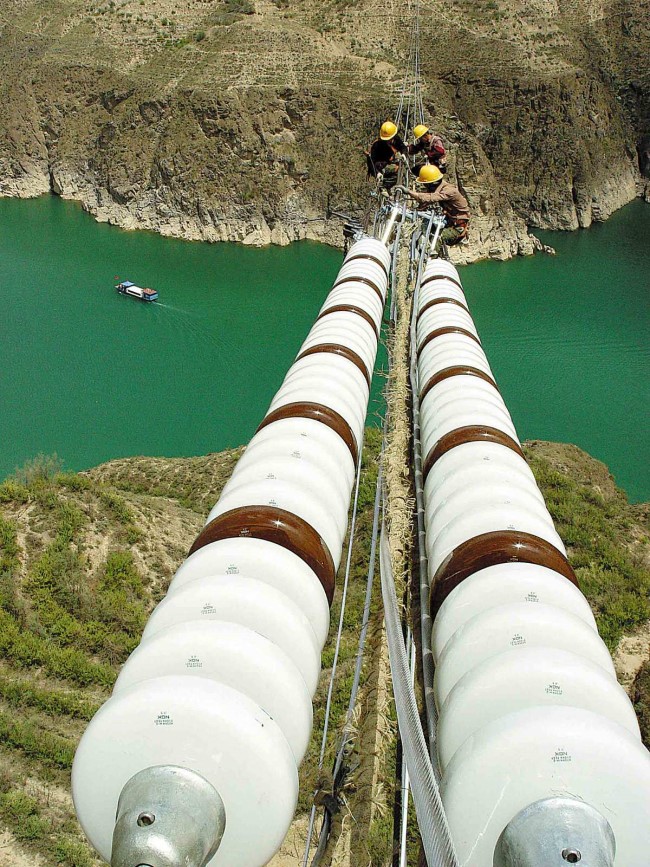Gansu makes great economic, ecological advances

Workers check a power line running across the Yellow River in Baiyin, Gansu province. [Photo/China Daily]
Gansu, once one of the impoverished provinces of inland China, has won its battle against extreme poverty and made great progress by changing its economic development mode in the past decade, senior officials said.
"Over the past 10 years, we adhered to the new development concepts and laid a solid foundation for high-quality development," Yin Hong, Party secretary of Gansu, said on Saturday at a news conference in the provincial capital, Lanzhou.
"The biggest achievement is that we have gradually established a modern industrial system," Yin said.
In addition to the traditional petrochemical industry, nonferrous metallurgy and equipment manufacturing, the northwestern province has seen rapid development in new energy, new materials, big data and biomedicine, and has China's first wind power base of 10 million kilowatts.
Gansu has recorded an average annual GDP growth rate of 6.9 percent since 2012, Yin said. In 2021, the province's GDP surpassed 1 trillion yuan ($147.8 billion), and its GDP per capita nearly doubled compared with 2012.
"Our economic development is now taking a sound and sustainable path," Yin said.
According to the provincial bureau of statistics, Gansu's GDP in the first half of the year increased by 4.2 percent year-on-year, reaching over 523 billion yuan.
Trade in the first half maintained fast growth. The total value of imports and exports in Gansu reached 32.58 billion yuan, a 24.6 percent increase year-on-year. Exports accounted for 6.16 billion yuan, an increase of 49.4 percent, and imports for 26.42 billion yuan, a 20 percent increase.
With deserts, semideserts, oases, grassland, wetland, mountains, glaciers and loess plateau, Gansu is one of the most geographically diverse provinces in northwestern China.
However, it is also one of the nation's most environmentally fragile areas. In 2017, more than 43 percent of Gansu's surface area, or 195,000 square kilometers, was desert land, and more than 27 percent was sandy. The fragile environment severely impeded the province's economic growth and posed a serious challenge to people's livelihoods.
With unremitting efforts over the past decade, 5.52 million people from 7,262 villages in 75 counties have been lifted out of poverty. Last year, Gansu's annual per capita income exceeded 10,000 yuan for the first time. Disposable income grew from 2,415 yuan in 2013 to 8,539 yuan in 2020.
Yin recalled that in 2013, when President Xi Jinping visited the village of Bulenggou in Dongxiang autonomous county, about 80 percent of the villagers lived in rough adobe homes on barren slopes, many of them without running water, electricity and other basic amenities. The village was accessed via dirt roads, and most of the villagers had not completed primary school education.
"Thanks to help from the government and society, the villagers have new houses with running water and convenient access to education and healthcare services," he said.
"They now have stable incomes, and the disposable income per capita exceeded 8,800 yuan last year," Yin said.
As an important ecological security barrier, Gansu shoulders the responsibility of conserving water that runs into the country's biggest rivers, fighting desertification and protecting biological diversity. Since the 18th National Congress of the Communist Party of China in 2012, the province has made great efforts to improve its environment.
"We bear in mind that green development is a matter of life and death for us," Gansu Governor Ren Zhenhe said at the news conference on Saturday.
"We must safeguard our clear sky, clean water and soil through pollution prevention and control, environmental protection, and ecological control and restoration," Ren said.
Gansu has launched the joint construction of three national parks-the Giant Panda, Qilian Mountains and Ruoergai-as well as the Yellow River waste clearance campaign to protect the water quality of the river's upper reaches.
In five years, over 1 million people will be relocated within the province to avoid being exposed to ecological and geological disasters, Ren added.
